Kristen Elise's Blog
May 21, 2017
The Buried Books of Herculaneum Part 6
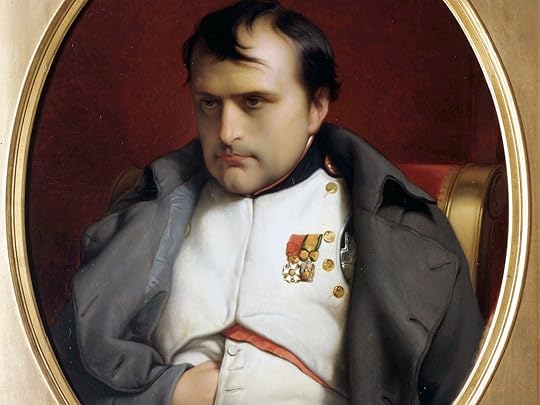 Napoleon Bonaparte
Napoleon BonaparteMaria Carolina became a close friend of Padre Piaggio. She safeguarded the papyrus scrolls from Herculaneum throughout the extensive fallout in Naples from the French Revolution, and she successfully kept them from the hands of the pillaging Napoleon Bonaparte – for a while...
Part 5 of this series continues the story of the excavations of Herculaneum, as we seek to unravel the answer to the Novel Travelist mystery: Why was the Villa dei Papyri never fully excavated?
Here we continue this story.
*****
In 1765, excavations at Herculaneum were halted in favor of excavating Pompeii. Two years later, young Ferdinand came of age and officially became King of Naples and the Two Sicilies. Ferdinand quickly became so unpopular among his subjects that they began to refer to him publicly as “King Big-Nose”.
His estranged queen, Maria Carolina, had befriended Padre Piaggio, the Vatican calligrapher tenaciously working to unroll and translate the papyrus scrolls from the Herculaneum villa. Carolina wholeheartedly supported this effort, despite – or perhaps because of - a complete lack of interest by her husband.
Then a world event utterly personal to Maria Carolina would interrupt.
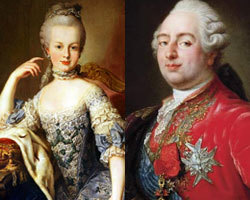 Marie Antoinette and Louis XVI of FranceLouis XVI of France was overthrown and beheaded. Shortly thereafter, Louis’ queen would also fall to the guillotine. Carolina’s outrage was two-fold. First, the infamous queen Marie Antoinette had been her younger sister. Second, Napoleon was now marching toward Naples.
Marie Antoinette and Louis XVI of FranceLouis XVI of France was overthrown and beheaded. Shortly thereafter, Louis’ queen would also fall to the guillotine. Carolina’s outrage was two-fold. First, the infamous queen Marie Antoinette had been her younger sister. Second, Napoleon was now marching toward Naples.As Napoleon’s army approached, Piaggio succeeded in transcribing and publishing the first papyrus scroll from Herculaneum. Maria Carolina packed up the scrolls, her husband, and her lover and fled to Sicily, leaving Piaggio behind to continue his work in private. After pillaging what the Royal family had left behind in Naples, Napoleon’s interest in the ruins of Herculaneum escalated to obsession almost overnight.
It was clearly something of Egyptian origin that had caught his eye. What, exactly, this might have been is explored in the first Katrina Stone novel, The Vesuvius Isotope .
From Naples, Napoleon headed directly to Egypt, and from there back to France. He immediately established a new French Institute of Egyptian Studies in Cairo whose highest priority tasks included the translation of the newly discovered Rosetta Stone, a commemoration of the 9th year of reign of Egyptian Pharaoh Ptolemy V.
Meanwhile, after Napoleon’s army had moved on, Carolina and her entourage returned to Naples. Having been abandoned by her lover and having always hated her husband, she threw herself into a restoration project that went hand in hand with brutal repression of anyone she deemed a pro-French traitor. Executions were held weekly in Piazza del Mercato, the Market Square of Naples.
Napoleon returned to Naples again in 1806. This time, the papyrus scrolls were left behind for him to seize.
Fortunately for history, the kingdom of Naples was granted to Napoleon’s sister Caroline and her husband. And Caroline took an interest in the scrolls. Caroline raised the wages of workmen unrolling the scrolls and funded the hiring of additional
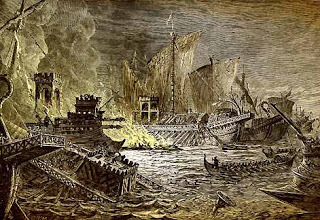 The Battle of Actiumapprentices. When Napoleon became emperor, she sent him her prized scroll as a gift. It described in detail the Battle of Actium and the fall of Cleopatra and Mark Antony.
The Battle of Actiumapprentices. When Napoleon became emperor, she sent him her prized scroll as a gift. It described in detail the Battle of Actium and the fall of Cleopatra and Mark Antony.Then Napoleon was defeated.
King Big-Nose was placed back on the throne for a third time, at which time he traded some of the scrolls to Britain’s King George IV in exchange for a giraffe. The English again tried a chemical softening process to unwind them. Again, the scrolls were ruined. No more had been unearthed.
To be continued in Part 7 of The Buried Books of Herculaneum.
This blog post explores a non-fictional theme or locale that is incorporated in The Vesuvius Isotope, a new novel by Kristen Elise. Buy The Vesuvius Isotope on Amazon.
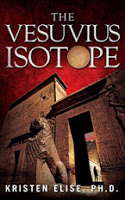
When her Nobel laureate husband is murdered, biologist Katrina Stone can no longer ignore the secrecy that increasingly pervaded his behavior in recent weeks. Her search for answers leads to a two-thousand-year-old medical mystery and the esoteric life of one of history’s most enigmatic women. Following the trail forged by her late husband, Katrina must separate truth from legend as she chases medicine from ancient Italy and Egypt to a clandestine modern-day war. Her quest will reveal a legacy of greed and murder and resurrect an ancient plague, introducing it into the twenty-first century.
Kristen Elise, Ph.D. is a drug discovery biologist and the author of The Vesuvius Isotope. She lives in San Diego, California, with her husband, stepson, and three canine children.
Published on May 21, 2017 15:20
March 26, 2016
American Association of University Women Event!

Dear readers,
I am SO excited to invite you to a very special upcoming event for a great cause.
The AAUW (American Association of University Women) is one of the foremost advocacy organizations in Washington DC, taking action on behalf of women on a broad range of economic and social issues that affect us every day. The mission statement of this group is "To advance equity for women and girls through advocacy, education, philanthropy, and research." And that is exactly what they do.
The Cabrillo-Diego Branch raises enough funds each year to send several middle-school girls to attend a week-long science summer camp at UCSD. As a UCSD alumnus (twice!) I am thrilled at the opportunity to do my small part to help pay it forward with this organization.
On April 16, my husband has generously offered up his restaurant as the forum for the Cabrillo-Diego Branch to hold their meeting, where I am honored to be the guest speaker. I'll be speaking about my education, my day job, and how the course of my career has led to the exciting and rewarding research I do by day AND the side benefit of writing and publishing novels. I hope that I can demonstrate to the audience the importance that education has had in my life and how it has given me so many choices and so many opportunities.
This is a free event, but if you purchase a book or stay for lunch, I will donate 20% of proceeds from book sales to the organization, and my husband will donate 20% of sales from the restaurant.
For anyone who is not local to San Diego but would like to hear more about AAUW or contribute to their cause, you may do so by visiting the group's website or contacting Janet Lipp, Program VP, at jlipp1@san.rr.com or (858) 455-5292. If you'd like to take advantage of the opportunity to purchase a Kristen Elise novel while donating 20% of the sale, please purchase the book directly on my website. Click "add to cart" to purchase with credit card or Paypal, and make the notation "AAUW" in your shopping cart.
But if you're local, I hope to see you there!
Sincerely, Kristen Elise
Saturday, April 16, 201610:30 am to 12:00 noonCucina Italiana4705 Clairemont DriveSan Diego, CA 92117(858) 274-9732
Published on March 26, 2016 09:03
February 23, 2016
Murder USA is Here!

Well color me thrilled! Murder USA is finally a reality!
If you like reading mysteries, thrillers, hard-boiled, or cozy... psychological or historical or action-packed or funny. If you like reading any brand of crime fiction whatsoever, please download your free copy at your choice of the links below. There is a wonderfully diverse collection of authors that came together to give us Murder USA and I'm delighted to be sharing this work with you. Enjoy!
Please note that I don't think Murder USA will EVER be free on Nook, but I hear that Nook users can download it for free on Smashwords. It's free on some of the Amazon sites (including U.S.), but we might need help from readers to make it free on Amazon in countries where it's currently showing the equivalent of $0.99 (they can click on the link that says 'Tell us about a lower price' and then link the iTunes site for the same country. Or they can just ask me for a copy.)
So without further delay, here are the links. Please feel free to download the book from here, send these links to readers, and forward this post along.
Amazon (any country)
Nook
Kobo
iTunes
Smashwords
Happy hunting,
Sincerely,
Kris
Published on February 23, 2016 19:22
January 23, 2016
The Pharaoh Hatshepsut and the Calcite Sphinx
Most people have heard of the Cleopatra VII, the enigmatic last pharaoh of Egypt. But did you know that Cleopatra was not the first female pharaoh? Cleopatra was preceded by about 1500 years by Hatshepsut, one of the most powerful and long-reigning pharaohs in Egyptian history. Had the two queens -- or, female kings, if you will -- lived contemporaneously, they just might have gotten along.
Both Hatshepsut and Cleopatra had to deal with a number of the same issues. Both were a threat to the men of their lineage who thought that they should be king instead. Both were smeared by their successors, leading to widespread inaccuracies in the historical records. And both dealt with these political slippery slopes by disguising themselves as men.
Indeed, we almost didn't learn Hatshepsut existed. Because her stepson almost successfully erased her from the historical record, we lost track of this powerful pharaoh for, oh, about 3400 years. It was only in the 19th century that translators of Egyptian heiroglyphs became increasingly annoyed by all of the female pronouns on the reliefs of a number of temples--not the least of which is the enormous complex at Dier al-Bahari we now recognize as the burial temple of Hatshepsut herself. Of course, we can't blame the historians for not recognizing at first that this temple was built by a female pharaoh. Not only was Hatshepsut's reign unusual, but she chose to build the temple in the Valley of the Kings, rather than the nearby Valley of the Queens. Why?
 The Mortuary Temple of Hatshepsut at Dier al-Bahari, EgyptIn all probability, because of semantics. There was no word in Hatshepsut's language for "queen regent," and so, a "queen" strictly referred to the wife of a king. But Hatshepsut wasn't having that, so she referred to herself as a powerful king, even taking the identity of Osiris, husband of Isis, as her patron god.
The Mortuary Temple of Hatshepsut at Dier al-Bahari, EgyptIn all probability, because of semantics. There was no word in Hatshepsut's language for "queen regent," and so, a "queen" strictly referred to the wife of a king. But Hatshepsut wasn't having that, so she referred to herself as a powerful king, even taking the identity of Osiris, husband of Isis, as her patron god.
But perhaps the most interesting of Hatshepsut's contributions is the calcite sphinx in Memphis. Thought to be an image of the pharaoh herself, this sphinx is the largest statue of pure calcite ever discovered. In contrast, the vast majority of statues in in the region are comprised of limestone, which was much more abundant in the time of the pharaohs. Why does this matter, you ask? Because limestone is less stable than calcite. So when the tombs and monuments of ancient Egypt finally wear to the ground, it is likely that the only thing left on this earth will be a single statue of a female pharaoh.
No wonder she's smiling.
 The Calcite Sphinx at MemphisThis blog post explores a non-fictional theme or locale that is incorporated in the third Katrina Stone novel, in progress by Kristen Elise. Buy The Vesuvius Isotope, the first Katrina Stone novel, in print
The Calcite Sphinx at MemphisThis blog post explores a non-fictional theme or locale that is incorporated in the third Katrina Stone novel, in progress by Kristen Elise. Buy The Vesuvius Isotope, the first Katrina Stone novel, in print or ebook
or ebook .
.
From the ancient ruins beneath Mount Vesuvius, a two-thousand-year-old document has emerged. It is the only text ever attributed to the ambitious, inquisitive, and cryptic last pharaoh of Egypt...
When her Nobel laureate husband is murdered, biologist Katrina Stone can no longer ignore the secrecy that has increasingly pervaded his recent behavior. Her search for answers leads to a two-thousand-year-old medical mystery and the life of one of history’s most enigmatic women. Following the trail forged by her late husband, Katrina must separate truth from legend as she chases medicine from ancient Italy and Egypt to a clandestine modern-day war. Her quest will reveal a legacy of greed and murder and resurrect an ancient plague into the twenty-first century.
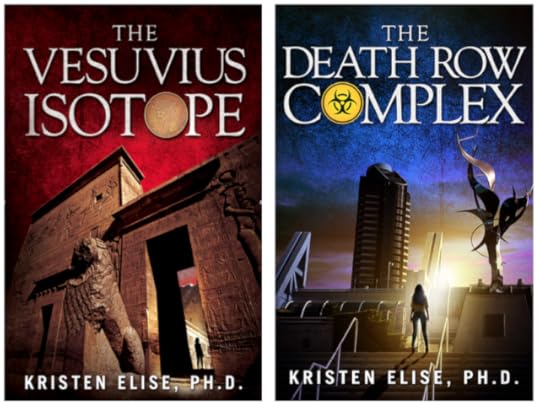
Kristen Elise, Ph.D. is a drug discovery biologist and the author of The Vesuvius Isotope and The Death Row Complex. She lives in San Diego, California, with her husband, stepson, and three canine children.
Both Hatshepsut and Cleopatra had to deal with a number of the same issues. Both were a threat to the men of their lineage who thought that they should be king instead. Both were smeared by their successors, leading to widespread inaccuracies in the historical records. And both dealt with these political slippery slopes by disguising themselves as men.
Indeed, we almost didn't learn Hatshepsut existed. Because her stepson almost successfully erased her from the historical record, we lost track of this powerful pharaoh for, oh, about 3400 years. It was only in the 19th century that translators of Egyptian heiroglyphs became increasingly annoyed by all of the female pronouns on the reliefs of a number of temples--not the least of which is the enormous complex at Dier al-Bahari we now recognize as the burial temple of Hatshepsut herself. Of course, we can't blame the historians for not recognizing at first that this temple was built by a female pharaoh. Not only was Hatshepsut's reign unusual, but she chose to build the temple in the Valley of the Kings, rather than the nearby Valley of the Queens. Why?
 The Mortuary Temple of Hatshepsut at Dier al-Bahari, EgyptIn all probability, because of semantics. There was no word in Hatshepsut's language for "queen regent," and so, a "queen" strictly referred to the wife of a king. But Hatshepsut wasn't having that, so she referred to herself as a powerful king, even taking the identity of Osiris, husband of Isis, as her patron god.
The Mortuary Temple of Hatshepsut at Dier al-Bahari, EgyptIn all probability, because of semantics. There was no word in Hatshepsut's language for "queen regent," and so, a "queen" strictly referred to the wife of a king. But Hatshepsut wasn't having that, so she referred to herself as a powerful king, even taking the identity of Osiris, husband of Isis, as her patron god.But perhaps the most interesting of Hatshepsut's contributions is the calcite sphinx in Memphis. Thought to be an image of the pharaoh herself, this sphinx is the largest statue of pure calcite ever discovered. In contrast, the vast majority of statues in in the region are comprised of limestone, which was much more abundant in the time of the pharaohs. Why does this matter, you ask? Because limestone is less stable than calcite. So when the tombs and monuments of ancient Egypt finally wear to the ground, it is likely that the only thing left on this earth will be a single statue of a female pharaoh.
No wonder she's smiling.
 The Calcite Sphinx at MemphisThis blog post explores a non-fictional theme or locale that is incorporated in the third Katrina Stone novel, in progress by Kristen Elise. Buy The Vesuvius Isotope, the first Katrina Stone novel, in print
The Calcite Sphinx at MemphisThis blog post explores a non-fictional theme or locale that is incorporated in the third Katrina Stone novel, in progress by Kristen Elise. Buy The Vesuvius Isotope, the first Katrina Stone novel, in print or ebook
or ebook .
.From the ancient ruins beneath Mount Vesuvius, a two-thousand-year-old document has emerged. It is the only text ever attributed to the ambitious, inquisitive, and cryptic last pharaoh of Egypt...
When her Nobel laureate husband is murdered, biologist Katrina Stone can no longer ignore the secrecy that has increasingly pervaded his recent behavior. Her search for answers leads to a two-thousand-year-old medical mystery and the life of one of history’s most enigmatic women. Following the trail forged by her late husband, Katrina must separate truth from legend as she chases medicine from ancient Italy and Egypt to a clandestine modern-day war. Her quest will reveal a legacy of greed and murder and resurrect an ancient plague into the twenty-first century.

Kristen Elise, Ph.D. is a drug discovery biologist and the author of The Vesuvius Isotope and The Death Row Complex. She lives in San Diego, California, with her husband, stepson, and three canine children.
Published on January 23, 2016 13:47
December 15, 2015
Win 30 Crime Novels! Via Sue Coletta
Readers! Don't miss this one...
Marred author Sue Coletta has initiated a Rafflecopter to win 30 crime novels... among them The Death Row Complex!
Sign up here for 30 freebies from award-winning and best-selling crime fiction novelists.
a Rafflecopter giveaway
Marred author Sue Coletta has initiated a Rafflecopter to win 30 crime novels... among them The Death Row Complex!
Sign up here for 30 freebies from award-winning and best-selling crime fiction novelists.
a Rafflecopter giveaway
Published on December 15, 2015 16:45
November 29, 2015
The Field: San Diego's Best Irish Pub as Featured in a Deleted Scene
 The Field, San DiegoAs they crossed the street, three blond, inebriated young women were crossing in the other direction while singing, each in a key totally unmatched with the other two.
The Field, San DiegoAs they crossed the street, three blond, inebriated young women were crossing in the other direction while singing, each in a key totally unmatched with the other two.“What do you do with a drunken sailor? What do you do with a drunken sailor? What do you do with a drunken sailor? Early in the MORNING!!”
The girls burst into fits of laughter as they passed, losing the ability to sing at all. Katrina and McMullan exchanged a highly amused glance as the same tune met them again, this time being played by a legitimate band.
“Shave his belly with a rusty razor, shave his belly with a rusty razor, shave his belly with a rusty razor, earl-eye in the MORNING!”
“Kick ass!” said McMullan as they neared “The Field,” San Diego’s boasted most authentic Irish pub.

“I can only assume you’re Irish?” Katrina said.
“Sean Patrick McMullan…what do you think!?”
Katrina held out her hand.
“Formerly Katrina McGuire. My grandfather was affectionately known as “The East Texas Leprachaun.”
The two shook hands dramatically.
Sean pretended not to have already known his companion’s maiden name. The nickname for her grandfather was, indeed, news to him, and he realized that not everything within this woman’s world had been revealed to the FBI.
“This place is the real deal,” Katrina said. “Literally - even the wood used to build it was imported from Ireland. They’ve got all the good stuff on tap, and if you’re into traditional Irish food, you’re in for something.”
As she said it, she realized that she had not eaten dinner and was totally famished. Without further discussion, they stepped toward the door. As they did, they could overhear the driver of a passing pedi-cab saying to his fare, “…and that’s ‘The Field’. It’s an actual Irish bar; they brought it here from Ireland piece by piece.”
Katrina turned to McMullan and said with a smile, “Told you.”
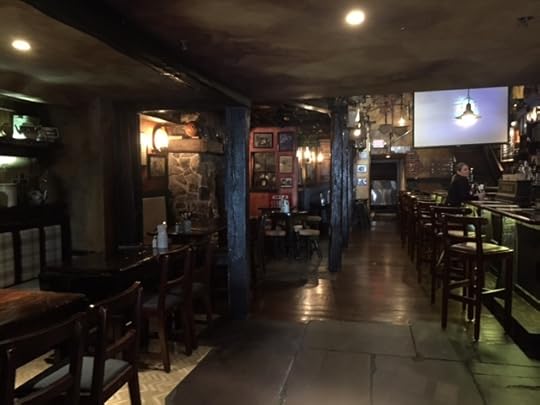
An outside patio was enclosed by an iron railing that broke in the middle, allowing access to the front door from the sidewalk on Fifth Avenue. Beneath the railing was a thick wooden ledge holding ashtrays. Chunky wooden stools in front of the ledge were occupied by small groups of smokers, feeding their collective vice while glancing at passers-by.
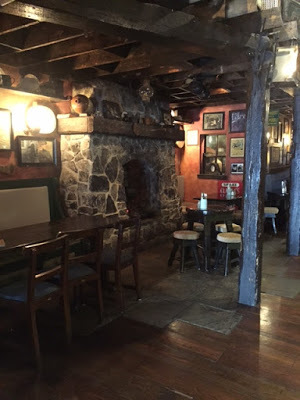
The inside of the pub, like all establishments in San Diego for many years, was smoke free. Nonetheless, a discerning nose could easily pick up the scent of ancient tobacco, embedded forever into the dark wood that built the tables, chairs, stools, bar and rafters. The imposing character of the thick wood created a dark environment that was warmed by the glow of a large fireplace opposite the bar. To the left of the bar, a small, raised stage held the three piece band still singing about a drunken sailor.
Small nooks held deep booths with padded benches and chairs; Katrina and McMullan settled into one, both sitting at the bench against the wall so as to observe the action in the room.

“Whot ken I gait fair yeh, Love?” a waitress asked.
“Two Guinesses and two menus, please,” Katrina shouted over the band, and winked at McMullan. As the bartender skipped off to pour the beers, Katrina leaned in to her companion, her mouth almost touching his ear as she spoke.
“Oh yeah, the staff is imported as well,” she said.
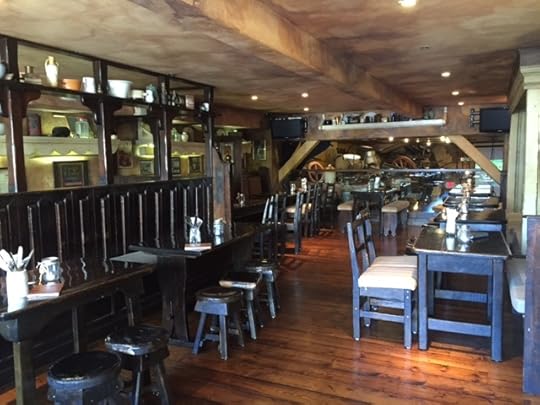
The above is a deleted scene from best-selling thriller The Death Row Complex
 by Kristen Elise.
by Kristen Elise. From the author:
The Irish pub in which Katrina and McMullan had dinner in the novel is based heavily on The Field. In the interest of not being sued, I had originally changed the name of the pub before deciding that the scene detracted a bit from the action that was going on at the time and removing it altogether... but now, here is the original scene, including the authentic background of the pub, for readers who would like to know a little bit more about this fun little slice of San Diego.
The Field really is San Diego's best Irish pub (in my opinion) and it really did come piece by piece from Ireland. It's a favorite haunt of mine. What Katrina and McMullan encounter there is typical of a Friday or Saturday evening downtown. If you visit my neck of the woods and you like Irish food, it's my #1 recommendation. Slainte!
Visit The Field at 544 5th Avenue, San Diego, CA, 92101
Published on November 29, 2015 13:31
October 31, 2015
The Buried Books of Herculaneum Part 5
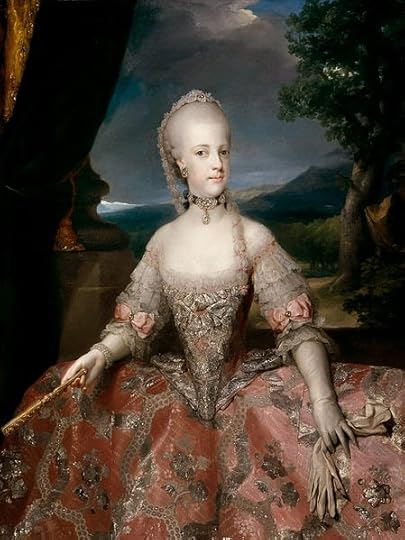 Maria Carolina of Austria
Maria Carolina of AustriaExcavations at Herculaneum were forcibly halted in favor of ongoing efforts at Pompeii, and so the secrets contained within the Villa would once again be forced to wait. Charles’ mother Elisabetta, the woman who had first initiated the work, died...
Part 4 of this series continues the story of the excavations of Herculaneum, as we seek to unravel the answer to the Novel Travelist mystery: Why was the Villa dei Papyri never fully excavated?
Here we continue this story.
*****
Despite the recent lack of interest in Herculaneum, one man remained enthusiastic about the papyrus scrolls recovered from the ash. Vatican calligrapher priest Padre Piaggio was the first to attempt unwinding the scrolls from the Villa dei Papiri without destroying them.
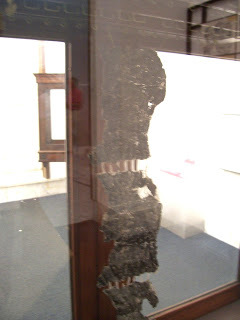 Piaggio's device, Naples Archeological MuseumPiaggio’s infinite patience and sense of innovation produced a mechanical device, now located in the Naples Archeological Museum, that could at long last unwind the scrolls, at a rate of one half-inch per day. It is this device that first appeared in Part 1 of this series.
Piaggio's device, Naples Archeological MuseumPiaggio’s infinite patience and sense of innovation produced a mechanical device, now located in the Naples Archeological Museum, that could at long last unwind the scrolls, at a rate of one half-inch per day. It is this device that first appeared in Part 1 of this series.Slowly and painstakingly, Padre Piaggio eventually succeeded in being the first to unroll one papyrus document from beneath the ruins of Herculaneum. This single act took four years.
Piaggio continued unrolling additional scrolls and he set to diligently copying their text. The former Vatican calligrapher produced remarkably faithful reproductions of the text despite its condition, and also despite the fact that he neither spoke nor read modern, let alone ancient, Greek.
Translation of the content was equally difficult. The papyrus was in such terrible condition, and so many pieces had been lost, that much of the author information and content was either missing or misunderstood. Indeed, several entire scrolls were literally translated backward in their entirety, and it was only many, many years later that this mistake was even recognized as such.
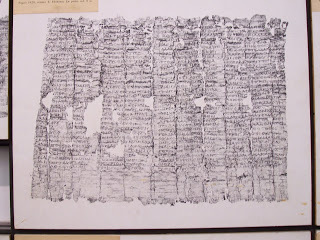 Flattened papyrus scroll from HerculaneumKing Charles III's son Ferdinand came of age in 1767 and became the arrogant, ignorant boy-king of Naples - an event that would no doubt have represented the final nail in the coffin of Herculaneum and the Villa dei Papiri had it not been for one unlikely variable.
Flattened papyrus scroll from HerculaneumKing Charles III's son Ferdinand came of age in 1767 and became the arrogant, ignorant boy-king of Naples - an event that would no doubt have represented the final nail in the coffin of Herculaneum and the Villa dei Papiri had it not been for one unlikely variable.Her name was Maria Carolina, and she would become Ferdinand’s queen despite her loudly voiced opinion on the matter: “You might as well cast me into the sea.” Maria Carolina was the elder sister of a girl who would become known to history as Marie Antoinette, and whose notorious fate would only intensify Maria Carolina’s hatred of all things French.
Maria Carolina became a close friend of Padre Piaggio. She safeguarded the papyrus scrolls from Herculaneum throughout the extensive fallout in Naples from the French Revolution, and she successfully kept them from the hands of the pillaging Napoleon Bonaparte – for a while.
To be continued in part 6, July 4...
This blog post explores a non-fictional theme or locale that is incorporated in The Vesuvius Isotope, a new novel by Kristen Elise. Buy The Vesuvius Isotope on Amazon.
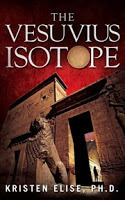
When her Nobel laureate husband is murdered, biologist Katrina Stone can no longer ignore the secrecy that increasingly pervaded his behavior in recent weeks. Her search for answers leads to a two-thousand-year-old medical mystery and the esoteric life of one of history’s most enigmatic women. Following the trail forged by her late husband, Katrina must separate truth from legend as she chases medicine from ancient Italy and Egypt to a clandestine modern-day war. Her quest will reveal a legacy of greed and murder and resurrect an ancient plague, introducing it into the twenty-first century.
Kristen Elise, Ph.D. is a drug discovery biologist and the author of The Vesuvius Isotope. She lives in San Diego, California, with her husband, stepson, and three canine children.
Published on October 31, 2015 14:24
September 26, 2015
The Buried Books of Herculaneum Part 4
Raimondo di Sangro, Prince of Sansevero and friend of King Charles, became the first to attempt opening the papyrus scrolls as they emerged from within the villa. A self-proclaimed "gifted" and "extraordinary" alchemist, di Sangro used mercury in an effort to soften the charred, brittle papyrus. The mercury dissolved the scrolls, and many of them were lost...
Part 3 of this series continues the story of the excavations of Herculaneum, as we seek to unravel the answer to the Novel Travelist mystery: Why was the Villa dei Papyri never fully excavated?
Here we continue this story.
*****
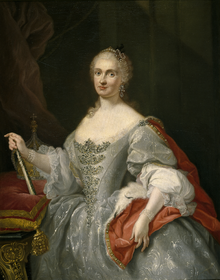 Maria Amalia of Saxony, Public DomainFour years after Charles succeeded to the throne, he married. His father, King Philip V, had sought a French bride for his first born in a feeble effort to cling to the French throne. Queen Elisabetta’s wishes prevailed, however, and Charles married Prussian Princess Maria Amalia, who had grown up in the very Austrian palace containing the first statues excavated from Herculaneum - the three veiled females and the statue of Cleopatra.
Maria Amalia of Saxony, Public DomainFour years after Charles succeeded to the throne, he married. His father, King Philip V, had sought a French bride for his first born in a feeble effort to cling to the French throne. Queen Elisabetta’s wishes prevailed, however, and Charles married Prussian Princess Maria Amalia, who had grown up in the very Austrian palace containing the first statues excavated from Herculaneum - the three veiled females and the statue of Cleopatra.Meanwhile, the second factor involved in bringing Herculaneum to light was the Enlightenment itself. The Grand Tour was in full swing, and the aristocratic travelers known to Italians as “milordi” – “my lords” – came from far and wide throughout Europe. Rome was a quintessential stopping point, and then Naples as well.
As rumors of the ancient treasures began making their way across Europe, increasing numbers of Grand Tourists became determined to see the ruins for themselves, as well as to purchase the multiple replicas of Herculaneum booty that were suddenly all the rage. Artists who could faithfully reproduce these coveted artifacts found abundant work in Naples.
One such artist was Camillo Paderni, who was both fascinated by the flawlessly frozen cross-sections of ancient Roman life and appalled that these cross-sections were being so brutally destroyed. As he toured the excavation sites, Paderni produced image upon image of the world formerly unbeknownst to the public. He also began writing letters of complaint about excavation leader Alcubierre.
 Winckelmann, Public DomainAnother of Alcubierre’s critics was Johann Joachim Winckelmann. Antiquarian and well-respected writer, Winckelmann’s scathing commentaries brought the methods of Alcubierre into the light and into posterity, observing that Alcubierre knew “as much of antiquities as the moon knows of crabs.”
Winckelmann, Public DomainAnother of Alcubierre’s critics was Johann Joachim Winckelmann. Antiquarian and well-respected writer, Winckelmann’s scathing commentaries brought the methods of Alcubierre into the light and into posterity, observing that Alcubierre knew “as much of antiquities as the moon knows of crabs.”In 1750, Alcubierre was pulled to a different post and replaced by Karl Weber, who produced the first true maps of the Villa dei Papiri and its surroundings as well as the many tunnels now leading through the area. Approximately 1100 additional scrolls were found under Weber, and King Charles himself was fascinated with them, until the inevitable fate of monarchy politics intervened.
King Charles’ father Philip, the King of Spain and of the two Sicilies, had died in 1754. By 1759, Charles could no longer shirk his responsibility to the kingdom, and he reluctantly left for Spain. Governing in Naples in his stead was a temporary stand-in until Charles’ spoiled, eight-year-old son Ferdinand could come of age. Excavations at Herculaneum were forcibly halted in favor of ongoing efforts at Pompeii, and so the secrets contained within the Villa would once again be forced to wait.
Charles’ mother Elisabetta, the woman who had first initiated the work, died.
To be continued in part 5...
This blog post explores a non-fictional theme or locale that is incorporated in The Vesuvius Isotope, a new novel by Kristen Elise. Buy The Vesuvius Isotope on Amazon.

When her Nobel laureate husband is murdered, biologist Katrina Stone can no longer ignore the secrecy that increasingly pervaded his behavior in recent weeks. Her search for answers leads to a two-thousand-year-old medical mystery and the esoteric life of one of history’s most enigmatic women. Following the trail forged by her late husband, Katrina must separate truth from legend as she chases medicine from ancient Italy and Egypt to a clandestine modern-day war. Her quest will reveal a legacy of greed and murder and resurrect an ancient plague, introducing it into the twenty-first century.
Kristen Elise, Ph.D. is a drug discovery biologist and the author of The Vesuvius Isotope. She lives in San Diego, California, with her husband, stepson, and three canine children.
Published on September 26, 2015 12:08
September 9, 2015
Newsletter: The Murder, USA "Anthology"
September 9,2015Hello!
I have an awesome project to announce! I've been cooking this thing up for a while, along with a fantastic group of talented, fascinating authors, and it is now officially past the point of no return. So here it is: The Murder, USA anthology. Except is not a true anthology. Let me explain:
In contrast to a true anthology, which implies a collection of short stories, I am collating a collection of excerpts from somewhere between 20 and 30 full-length, published novels. Each of these novels falls somewhere in some form of crime fiction/mystery/thriller genre - from legal thriller, to cozy mystery, to action thriller, to romantic mystery, to paranormal thriller. There is something in here for everyone. It will be FREE, and as a subscriber to this mailing list, you'll be one of the first to get it.
In addition to the common theme of genre, there is another common thread: Murder, USA is a travelogue. Each of these excerpts is set somewhere in the United States, and the setting plays a bit of a role in the story. My vision for this project is that the finished product is "a murder tour of the nation." I have now read many of the excerpts, and let me tell you... it's going to be awesome. We've got quite a diverse collection of talented authors and ... again... there is something in here for everyone. Find your next favorite author!
The table of contents will be organized by location and it will list the novel, author, location, and subgenre (cozy mystery, international thriller...,) so there are many ways for a reader to glance through the table of contents and pick out the excerpts of interest to him/her. And there will be links to the full-length novel for purchase at the end of each excerpt, so you'll have easy access to the rest of the story!
Stay tuned as well for Murder, International - the international version. This one is a bit "behind" in terms of production, and the USA version will definitely be available first.
Last, but not least, I'd like to let my readers know that there's a promotion coming up for The Vesuvius Isotope. The ebook will be discounted to $0.99 from October 1-15. Please feel free to spread the word if you've got friends who might like the novel and be interested picking up a copy at a discount. Or, as always, they can just subscribe to this newsletter and get it for free!If you were forwarded this newsletter and would like to subscribe, I'll send you a free e-copy of The Vesuvius Isotope.
Happy hunting,
Sincerely,
Kris
I have an awesome project to announce! I've been cooking this thing up for a while, along with a fantastic group of talented, fascinating authors, and it is now officially past the point of no return. So here it is: The Murder, USA anthology. Except is not a true anthology. Let me explain:
In contrast to a true anthology, which implies a collection of short stories, I am collating a collection of excerpts from somewhere between 20 and 30 full-length, published novels. Each of these novels falls somewhere in some form of crime fiction/mystery/thriller genre - from legal thriller, to cozy mystery, to action thriller, to romantic mystery, to paranormal thriller. There is something in here for everyone. It will be FREE, and as a subscriber to this mailing list, you'll be one of the first to get it.
In addition to the common theme of genre, there is another common thread: Murder, USA is a travelogue. Each of these excerpts is set somewhere in the United States, and the setting plays a bit of a role in the story. My vision for this project is that the finished product is "a murder tour of the nation." I have now read many of the excerpts, and let me tell you... it's going to be awesome. We've got quite a diverse collection of talented authors and ... again... there is something in here for everyone. Find your next favorite author!
The table of contents will be organized by location and it will list the novel, author, location, and subgenre (cozy mystery, international thriller...,) so there are many ways for a reader to glance through the table of contents and pick out the excerpts of interest to him/her. And there will be links to the full-length novel for purchase at the end of each excerpt, so you'll have easy access to the rest of the story!
Stay tuned as well for Murder, International - the international version. This one is a bit "behind" in terms of production, and the USA version will definitely be available first.
Last, but not least, I'd like to let my readers know that there's a promotion coming up for The Vesuvius Isotope. The ebook will be discounted to $0.99 from October 1-15. Please feel free to spread the word if you've got friends who might like the novel and be interested picking up a copy at a discount. Or, as always, they can just subscribe to this newsletter and get it for free!If you were forwarded this newsletter and would like to subscribe, I'll send you a free e-copy of The Vesuvius Isotope.
Happy hunting,
Sincerely,
Kris
Published on September 09, 2015 19:35
August 18, 2015
The Enigma of Cleopatra: Everything You Know of Her is Wrong
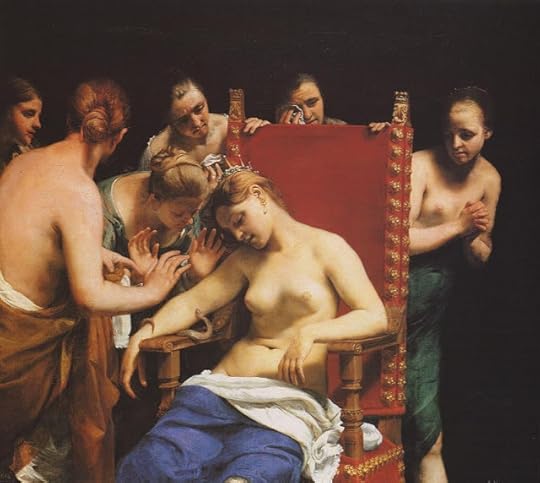 Photo Credit: The Death of Cleopatra, by Guido Cagnacci 1658 Public DomainA recent post on www.history.com details lesser-known or poorly understood facts about Cleopatra VII, a strong theme detailed in historical thriller The Vesuvius Isotope.
Photo Credit: The Death of Cleopatra, by Guido Cagnacci 1658 Public DomainA recent post on www.history.com details lesser-known or poorly understood facts about Cleopatra VII, a strong theme detailed in historical thriller The Vesuvius Isotope. From the blog post...
From the blog post...1. Cleopatra was not Egyptian.While Cleopatra was born in Egypt, she traced her family origins to Macedonian Greece and Ptolemy I Soter, one of Alexander the Great’s generals. Ptolemy took the reigns of Egypt after Alexander’s death in 323 B.C., and he launched a dynasty of Greek-speaking rulers that lasted for nearly three centuries. Despite not being ethnically Egyptian, Cleopatra embraced many of her country’s ancient customs and was the first member of the Ptolemaic line to learn the Egyptian language.Read the rest at www.history.com
This blog post explores a non-fictional theme or locale that is incorporated in The Vesuvius Isotope, the first Katrina Stone novel. Buy The Vesuvius Isotope in print
 or ebook
or ebook .
.
From the ancient ruins beneath Mount Vesuvius, a two-thousand-year-old document has emerged. It is the only text ever attributed to the ambitious, inquisitive, and cryptic last pharaoh of Egypt...
When her Nobel laureate husband is murdered, biologist Katrina Stone can no longer ignore the secrecy that has increasingly pervaded his recent behavior. Her search for answers leads to a two-thousand-year-old medical mystery and the life of one of history’s most enigmatic women. Following the trail forged by her late husband, Katrina must separate truth from legend as she chases medicine from ancient Italy and Egypt to a clandestine modern-day war. Her quest will reveal a legacy of greed and murder and resurrect an ancient plague into the twenty-first century.

Kristen Elise, Ph.D. is a drug discovery biologist and the author of The Vesuvius Isotope and The Death Row Complex. She lives in San Diego, California, with her husband, stepson, and three canine children.
Published on August 18, 2015 20:59



